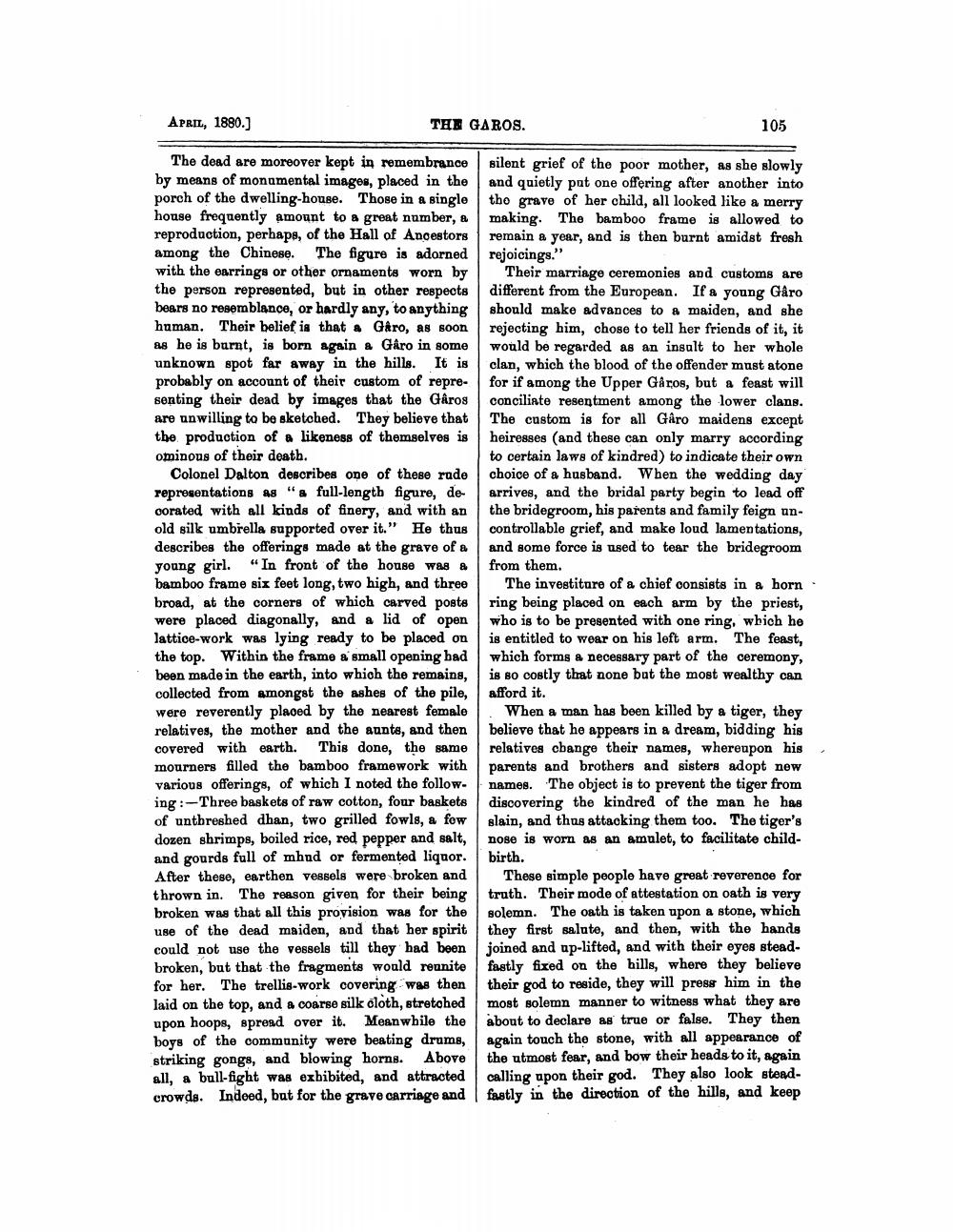________________
APRIL, 1880.)
THE GAROS.
105
The dead are moreover kept in remembrance by means of monumental images, placed in the porch of the dwelling-house. Those in a single house frequently amount to a great number, a reproduction, perhaps, of the Hall of Ancestors among the Chinese. The figure is adorned with the earrings or other ornaments worn by the person represented, but in other respects bears no resemblance, or hardly any, to anything human. Their belief is that a Garo, as soon as he is burnt, is born again a Gâro in some unknown spot far away in the hills. It is probably on account of their custom of representing their dead by images that the GÂros are unwilling to be sketched. They believe that the production of a likeness of themselves is ominous of their death.
Colonel Dalton describes one of these rade representations 48 "& full-length figure, de corated with all kinds of finery, and with an old silk umbrella supported over it." He thus describes the offerings made at the grave of a young girl. "In front of the house was a bamboo frame six feet long, two high, and three broad, at the corners of which carved posts were placed diagonally, and a lid of open lattice-work was lying ready to be placed on the top. Within the frame a small opening bad been made in the earth, into which the remains, collected from amongst the ashes of the pile, were reverently placed by the nearest female relatives, the mother and the aunts, and then covered with earth. This done, the same mourners filled the bamboo framework with various offerings, of which I noted the following:-Three baskets of raw cotton, four baskets of unthreshed dhan, two grilled fowls, a fow dozen shrimps, boiled rice, red pepper and salt, and gourds full of mhud or fermented liquor. After these, earthen vessels were broken and thrown in. The reason given for their being broken was that all this provision was for the use of the dead maiden, and that her spirit could not use the vessels till they had been broken, but that the fragments would reunite for her. The trellis-work covering was then laid on the top, and a coarse silk cloth, stretohed upon hoops, spread over it. Meanwhile the boys of the community were beating drums, striking gongs, and blowing horns. Above all, a bull-fight was exbibited, and attracted crowds. Indeed, but for the grave carriage and
silent grief of the poor mother, as she slowly and quietly put one offering after another into tho grave of her child, all looked like a merry making. The bamboo frame is allowed to remain a year, and is then burnt amidst fresh rejoicings."
Their marriage ceremonies and customs are different from the European. If a young Gåro should make advances to a maiden, and she rejecting him, chose to tell her friends of it, it would be regarded as an insult to her whole clan, which the blood of the offender must atone for if among the Upper Gåros, but a feast will conciliate resentment among the lower clans. The custom is for all Gâro maidens except heiresses (and these can only marry according to certain laws of kindred) to indicate their own choice of a husband. When the wedding day arrives, and the bridal party begin to lead off the bridegroom, his parents and family feign ancontrollable grief, and make loud lamentations, and some force is used to tear the bridegroom from them.
The investiture of a chief consists in a horn. ring being placed on each arm by the priest, who is to be presented with one ring, which he is entitled to wear on his left arm. The feast, which forms a necessary part of the ceremony, is so costly that none but the most wealthy can afford it.
When a man has been killed by a tiger, they believe that he appears in a dream, bidding his relatives change their names, whereupon his parents and brothers and sisters adopt new names. The object is to prevent the tiger from discovering the kindred of the man he has slain, and thus attacking them too. The tiger's nose is worn as an amulet, to facilitate childbirth.
These simple people have great reverence for truth. Their mode of attestation on oath is very solemn. The oath is taken upon a stone, which they first salute, and then, with the hands joined and up-lifted, and with their eyes steadfastly fixed on the hills, where they believe their god to reside, they will press him in the most solemn manner to witness what they are about to declare as true or false. They then again touch the stone, with all appearance of the utmost fear, and bow their heads to it, again calling upon their god. They also look steadfastly in the direction of the hills, and keep




